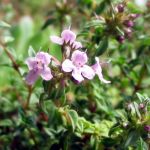| Common Name: |
Caraway Thyme |
| Botanical Name: |
Thymus herba-barona |
| Genus: |
Thymus |
| Family: |
Lamiaceae |
| Native Location: |
Corsica and Sardinia |
| Cultivation: |
Well-drained soil in sun. Most thymes prefer neutral to alkaline soil and thrive in stony or rocky situations. Thymes dislike wet winters, and benefit from a layer of gravel to protect the foliage from contact with wet soil. In autumn remove fallen leaves that settle on thyme plants as these may cause rotting. Trim lightly after flowering and remove dead flower heads to encourage bushiness. Remove green shoots of variegated cultivars to maintain variegation. In areas with cold, damp winters, T. camphoratus is best grown in an alpine house. Thymus vulgaris is used in companion planting to control flea beetles, cabbage white butterflies, and other cabbage pests. |
| Propagation: |
By seed sown in spring (species only); by softwood or semi-ripe cuttings in summer; by division in spring. |
| Harvest: |
Whole plants and flowering tops are collected in summer, as flowering begins, and distilled for oil, or dried for elixirs, liquid extracts, and infusions. Sprigs are picked during the growing season and used fresh, or dried for infusions. |
| Variations: |
Lemon-Scented
syn. f. citrata
Lemon Caraway
Has lemon-scented leaves and mauve flowers. |
Nutmeg
Has nutmeg-scented leaves and darker pink flowers in late summer. |
|
| Height: |
5-10cm (2-4in) |
| Width: |
60cm (24in) |
| Hardiness: |
Z6-8 |
| Parts Used: |
Leaves |
| Properties: |
An aromatic herb with a caraway scent. |
| Culinary Uses: |
Leaves are traditionally used to flavor a baron of beef; also to flavor soups, game and meat dishes in which wine and garlic predominate. |
| Bibliography: |
The Encyclopedia of Herbs by Deni Bown Copyright © 1995, 2001 Dorling Kindersley Limited. pg 387-388
|

